Punjab Board 12th Biology 2023 : Most Important Questions with Answers
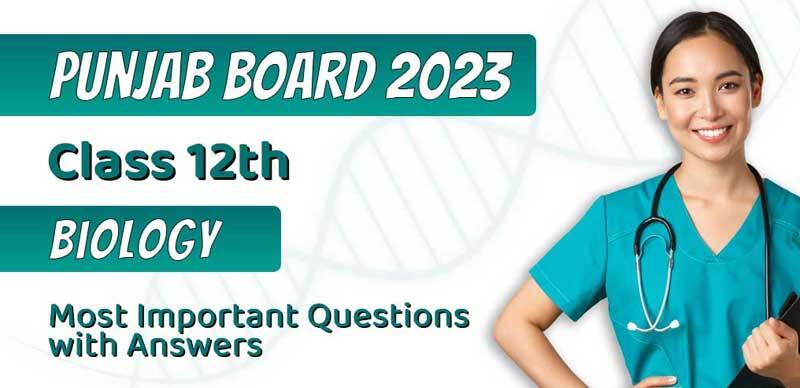
SHARING IS CARING
If our Website helped you a little, then kindly spread our voice using Social Networks. Spread our word to your readers, friends, teachers, students & all those close ones who deserve to know what you know now.
Punjab Board 12th Biology 2023 : Most Important Questions with Answers
Students preparing for Punjab Board Class 12th Biology paper must go through the practice questions for Class 12th 2023. You can read important practice questions in this article. Students can analyze their performance and work on the weak sections.
Biology - VVI Most Important Questions with Answers
Q.1. Related genera belong to the same:-
a) species
b) variety
c) family
d) breed.
Q.2. The casparian strips are found in:
a) epidermis
b) pericycle
c) endodermis
d) none of thea bove
Q.3. Which one is emergency gland?
a) Testis
b) adrenal
c) thymus
d) pituitary
Q.4. Emulsified fat is broken down to fatty acids and glycerol by:
a) lipase
b) amylase
c) trypsin
d) bilesalts
Q.5. Genetic material of retroviruses:
a) DNA
b) RNA
c) both DNA and RNA
Q.6. Mannitol is stored food in:
a) chara
b) porphyra
c) fucus
d) gracilaria
Q.7. Respiratory centre is situated in:
a) cerebellum
b) medulla oblongata
c) hypothalamus
d) cerebrum
Q.8. All veins carry deoxygenated blood except:
a) renal vein
b) hepatic vein
c) pulmonary veins
d) hepaticportal veins
Q.9. Which one of the following animal phyla does not have a coelom:
a) platy helminthes
b) annelida
c) mollusca
d) echinodermata.
Q.10. The basic functional of kidneyis:
a) pyramid
b) nephron
c) nephridium
d) henle, sloop
Q.11. Aleurone layer of maize grain is rich in
a) protein
b) starch
c) lipids
d) auxin
Q.12. Number of bones present in cranium is:
a) 10
b) 8
c) 12
d) 14
Q.13. In unilocular ovary with a single ovule the placentation is:
a) basal
b) freecentral
c) axilemarginal.
Q.14. Vascular bundles are closed when they have:
a) cambium
b) lack cambmium
c) lack pericycle
d) lack endodermis.
Q.15. Protein are a polymerisation product of
a) muramic acid
b) glucose
c) amino acids
d) none
Q.16. Energy currency of cellis is:
a) ADP
b) ATP
c) GDP
d) NAD
Fill in the blanks:
Q.17. Organ of corti is present on..............................membrane.
Ans. Basilar membrane
Q.18. ............and monocytes are phagocytic cells.
Ans. Neutrophils.
Q.19. ..............plant hormone helps in ripening of fruits.
Ans. Ethylene
Q.20. ...............is the property of living organisms to emit light.
Ans. bioluminescence
Q.21. Sclereids and sclerenchyma fibers belong to ...................................tissues.
Ans. Sclerenchyma
Q.22. Animal cells do not possess..............................organelle.True/false:
Ans. Centrosome
Q.23. Fresh chyme is alkaline in reaction.
Ans. False
Q.24. Glucose gets stored in the form of glycogen in liver.
Ans. true
Q.25. C4 plants are specialized to live in cold conditions.
Ans. False
Q.26. Fern Azolla pinnata is inoculated in rice fields to increase nitrogen fertility.
Ans. true
Q.27. Capsid is the proteinaceous covering of viral genome.
Ans. True
Q.28. Plasmodesmata is a thin and cementing layer between two adjacent cells.
Ans. false
Q.29. Bile juice contains no digestive enzymes yet it is important for digestion. Why?
Ans. Bile has no enzymes but contains salts like sodium bicarbonate that reduces the surface tensionof largefatdroplets and break them into many small droplets by a process known asemulsification .these small fat droplets present large surface area for lipase to act upon them.
Q.30. What happens when milk is converted into curd?
Ans. Milk is converted into curd due to denaturation of proteins. In denaturation globular proteins areconvertedinto fibrous proteins. This involves a change in physical, chemical andbiological properties of proteinmolecules.
Q.31. What are the modifications that are observed in the bird that help them fly?
Ans.
i) streamlined body for rapid and smooth movement
ii) Covering of feathers for insulation
iii) Forelimbs modified into wings
iv) Presence of pneumatic bones to reduce weight.
Q.32. How important is the presence of air bladder in Pisces?
Ans. Air bladder in Pisces helps in maintaining buoyancy. Thus, it helps fishes to ascend or descend and stay in the water current.
Q.33. Define respiratory quotient. What is its value for fat?
Ans. The respiratory quotient can be defined as the ratio of the volume of CO2 evolved to the volume of O2 consumed during respiration. The RQ for fats is always less than one.
Q.34. raw the structure of amino acid alanine?
Ans.
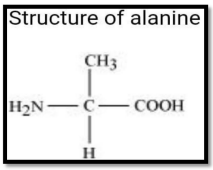
Q.35. Write two differences between endocrine and exocrine glands.
Ans. Endocrine glands:
i) these glands discharge their secretions directly into the blood.
ii) They have no ducts.eg thyroid gland.
b) Exocrine glands:
i) these glands discharge their secretions into ducts.
ii) They have ducts. e.g. Salivary glands.
Q.36. Why mitosis is called equational cell division?
Ans. Mitosis is the process of cell division in which chromosomes replicate and get equally distributed into two daughter cells. The chromosome number in each daughter cell is equal tothat in the parent cell.
Q.37. What are porins? What role do they play in diffusion?
Ans. Porins are the type of proteins which form pores of larger sizes in the outer membranes of plastids and mitochondria. They help in facilitating the passive transport of small-sized protein molecules.
Q.38. What happens when a pressure greater than the atmospheric pressure is applied to pure water or a solution?
Ans. The water potential of pure water or a solution increases on the application of pressure values more than the atmospheric pressure. Pure water has zero water potential and the solution has s have negatives water potential. Thus water potential can be raised from zero to positive values.
Q.39. What is the basis of classification of algae?
Ans.
i) Major photosynthetic pigments present.
ii) Form of food stored.
iii) Cell wall composition.
iv) Number of flagella and position of insertion.
Q.40. Why xylem and phloem are called complex tissues?
Ans. Xylem and phloem are known as complex tissues because they are made of more than onetype of cells. Thesecells work in a coordinated manner, as a unit, to perform the various functions of the xylemand phloem.
Q.41. What are nuclear pores? State their function.
Ans. Nuclear pores are tiny holes present in the nuclear membrane of the nucleus. They are formedbythefusion of two nuclear membranes. These holes allow specific substances to betransferred intoacell andout from it. They allow molecules such as RNA and proteins to move in both directions, betweenthenucleus and the cytoplasm.
Q.42. What do you mean by the term Herbarium? Briefly explain.
Ans. A herbarium is a collection of pressed, dried and labelled plant specimens and data associated with it which is used for scientific study. The specimens are arranged by a classification scheme. These are used for plant identification. It has details of plant locations, habitat, abundance and flowering and fruiting periods.
- The first step in preparing a herbarium specimen is a field visit and collection of specimen.
- The specimen is then spread on a blotting sheet and is placed in the press for drying.
- The dry specimen is then mounted on the herbarium sheet.
- The specimen is preserved using 2% mercuric chloride fungicide.
- After proper labelling of it, it is finally stored.
Q.43. What are the characteristics features of Euglenoids?
Ans. Some characteristic features of Euglenoids are as follows.
• Euglenoids (such as Euglena) are unicellular protists commonly found in fresh water.
• Instead of the cell wall, a protein-rich cell membrane known as pellicle is present.
• They bear two flagella on the anterior end of the body.
• A small light sensitive eye spot is present.
• They contain photosynthetic pigments such as chlorophyll and can thus prepare their own food. However, in the absence of light, they behave similarly to heterotrophs by capturing other small aquatic organisms.
• They have both plant and animal-like features, which makes them difficult to classify and hence they are called as connecting link between plants and animals.
Q.44. What is meant by double circulation? What is its significance?
Ans. Double circulation is a process during which blood passes twice through the heart during one complete cycle. This type of circulation is found in amphibians, reptiles, birds, and mammals. However, it is more prominent in birds and mammals as in them the heart is completely divided into four chambers – the right atrium, the right ventricle, the left atrium, and the left ventricle.
The movement of blood in an organism is divided into two parts:
(i) Systemic circulation : Systemic circulation involves the movement of oxygenated blood from the left ventricle of the heart to the aorta. It is then carried by blood through a network of arteries, arterioles, and capillaries to the tissues. From the tissues, the deoxygenated blood is collected by the venules, veins, and vena cava, and is emptied into the left auricle.
(ii) Pulmonary circulation : Pulmonary circulation involves the movement of deoxygenated blood from the right ventricle to the pulmonary artery, which then carries blood to the lungs for oxygenation. From the lungs, the oxygenated blood is carried by the pulmonary veins into the left atrium.
Hence, in double circulation, blood has to pass alternately through the lungs and the tissues.
Significance of double circulation: The separation of oxygenated and deoxygenated blood allows a more efficient supply of oxygen to the body cells. Blood is circulated to the body tissues through systemic circulation and to the lungs through the pulmonary circulation.
Q.45. Write three differences between blood and lymph.
Ans.
| Blood | Lymph |
| 1. Blood is pumped by the heart in the body. 2. Blood carries oxygen in the body. 3. Blood is a red-coloured fluid contain RBC. 4. The flow of blood vessels is fast. 5. The kidneys purify the blood. |
1. Lymph moved along by the normal function of the body. 2. Lymph removes waste from the body system. 3. Lymph is a colourless fluid and does not contain RBC. 4. The flow of lymph is slow. 5. Lymph is purified in the lymph node itself. |
Q.46. Describe the structure of nucleus with the help of labeled diagram.
Ans. Nucleus: Nucleus is relatively a large organelle controlling all the activities of the eukaryotic cells. Nucleus is a specialized double membrane bound protoplasmic body which contains all the genetic information of controlling cellular metabolism and transmission to the posterity.
A nucleus in non-dividing phase is called interphase nucleus and a typical interphase nucleus is differentiated into nuclear envelope, nucleoplasm or nuclear matrix, nucleolus and chromatin.
- Nuclear envelope: It bounds the nucleus on the outside and separates it from the cytoplasm. It is made up of two membranes-outer and inner. The inner membrane is smooth whereas the outer membrane may be smooth or its cytoplasmic surface may bear ribosomes like the RER. The outer membrane is often connected to ER. These two membranes of the nuclear envelope are separated by a space known as perinuclear space. The space is 10 to 50 nm in width.
Nuclear envelope contains a large number of complex pores which are formed by the fusion of its two membranes. The nuclear pores control the passage of substances to inside or outside of the nucleus e.g., RNA, ribosomes, proteins.
- Nucleoplasm: It is a transparent, semi-fluid and colloidal substannce which fills the nucleus. It contains nucleolus and highly extended and elaborate nucleoprotein fibres called chromatin.
- Nucleolus: It is spherical structure found in the nucleoplasm. It is not separated from rest of the nucleoplasm as it is not bound by a membrane. It is the site for ribosomal RNA synthesis.
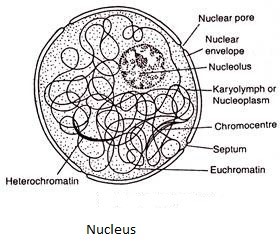
Q.47. State the location and function of different types of meristems.
Ans. On the basis of location, meristems are of three types, apical, intercalary and lateral.
(i) Apical: It is present at the apices of stem, root and their branches.
Functions: It helps in growth in length and formation of primary tissues.
(ii) Intercalary: It is found above or below stem nodes and leaf bases.
Functions: It helps in growth of internodes, growth in leaves and correction of position in lodged stems.
(iii) Lateral:
(a) Phellogen (Cork cambium): It develops from hypodermis in stems and pericycle in roots. Function: Formation of protective cork (phellem) and aerating lenticles on the outside and secondary cortex (phelloderm) on the inner side.
(b) Vascular Cambium: In stem it is formed from intra-fascicular cambial strips and interfascicular strips. In root it develops from conjuctive parenchyma and pericycle. Function: Formation of secondary phloem on the outer side and secondary xylem on the inner side. Vascular rays are formed at intervals for radial conduction.
Q.48. What is a flower? Describe the parts of a typical angiospermic flower.
Ans. A flower is a shoot which is specialized in taking part in the sexual reproduction of angiosperms.
Parts of Angiospermic Flower: A flower has a stalk called pedicel. The base of the flower is thick. It accommodates all the components. It is called thalamus. It has nodes and internodes. The various parts of the flower are called floral organs. They are of four types, namely Sepals, petals, stamens and carpels.
Sepal or Calyx: They are green outermost and lowermost floral organs. They can be free (polysepalous) or fused(gamosepalous). An extra whorl of green bracts called epicalyx may occur in some flowers. Sepals aids in protection and support other floral organs.
Petals or Corolla: They are brightly coloured flat leaf-like floral organs which lie inside to sepals and outside the stamens. They may be free (polypetalous) or fused (gamopetalous). Their major function is to attract pollinating animals.
Stamens or Androecium: They are male reproductive organs of a flower. They may be borne directly over the thalamus or attached to petals (epipetalous). Stamens can be free or fused by their filaments (adelphous condition), anthers (syngenesious) or both (synandrous). Each stamen has a thread like a stalk and knob-like anther. Anther is bilobed and has four sporangia. Pollen grains are formed inside the sporangia of the anther.
Carpels or Gynaecium: They are female reproductive organs of a flower. Carpels may be free (apocarpous) or fused (syncarpous). A free unit is called pistil. It has three parts, namely stigma, style and ovary. Stigma is the terminal part of the pistil which receives and nourishes the pollen grains. A style is a stalk that raises the stigma above the ovary. An ovary is a basal swollen part which bears ovules over the placentae. Ovules later ripen to form seeds while ovary develops into a fruit.
Q.49. Describe evolutionary changes in the pattern of heart among the vertebrates.
Ans. Heart is a hollow muscular organ present in all vertebrates which pump blood to whole of the body. Evolutionary change in the heart is observed on the basis of separation of oxygenated and deoxygenated blood for efficient oxygen transport to the body.
Fish heart- It is made up of 2 chambers- one auricle and one ventricle. Since there is no division of auricles and ventricles, deoxygenated blood passes through it which enters the gills for oxygenation. It has two additional chambers such as sinus venosus and conus arteriosus.
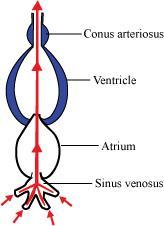
Amphibian heart- It has 3 chambers- 2 auricles and one ventricle. The auricles are divided by a septum while ventricle is undivided. Additional chambers such as sinus venosus and conus arteriosus are also present. The deoxygenated blood from whole body enters the right auricle while oxygenated blood enters the left auricle from the lungs and ultimately two types of blood get mixed up in ventricle.
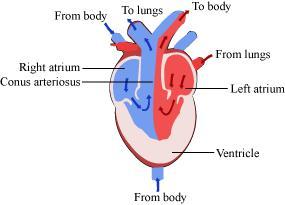
Reptilian heart- It is incompletely 4 chambered except in crocodiles, alligators and gharials. They have only one accessory chamber called sinus venosus. The reptilian heart also shows mixed blood circulation.
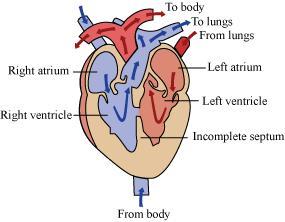
Avian and mammalian hearts- It is made up of four chambers- 2 auricles and two ventricles. These two pairs of chambers separate oxygenated and deoxygenated blood. The upper two chambers are called atria and the lower two chambers are called ventricles. The chambers are separated by a muscular wall that prevents the mixing of the blood rich in oxygen with the blood rich in carbon dioxide.
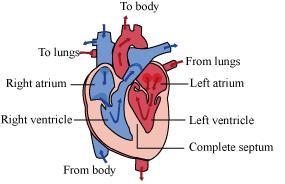
Q.50. Write six characteristic features of class mammalia.
Ans. Characteristics of class - Mammalia are ; Developed mammary glands are found in females, mothers feed milk to young ones secreted by mammary glands. Their body is divided into head, neck, thorax, abdomen and tail. Hair are present as exoskeleton on the body. Ear pinnae (External ear) is present. They are warm-blooded. They respire through the lungs. The heart is four-chambered. The heart has 2 auricles and 2 ventricles. Most of the mammals are viviparous.
Examples are: Pteropus (bat), Homo (man), Herpestes (mongoose), Ratus (rat), Panthera (lion, tiger).
Punjab Board Class 12 Study Material
| Punjab Board Class 12 Study Material | |
| Punjab Board Class 12 Books | Punjab Board Class 12 Textbook Solutions |







 Profile
Profile Signout
Signout














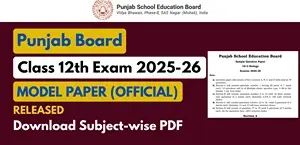

 Quiz
Quiz
 Get latest Exam Updates
Get latest Exam Updates 










